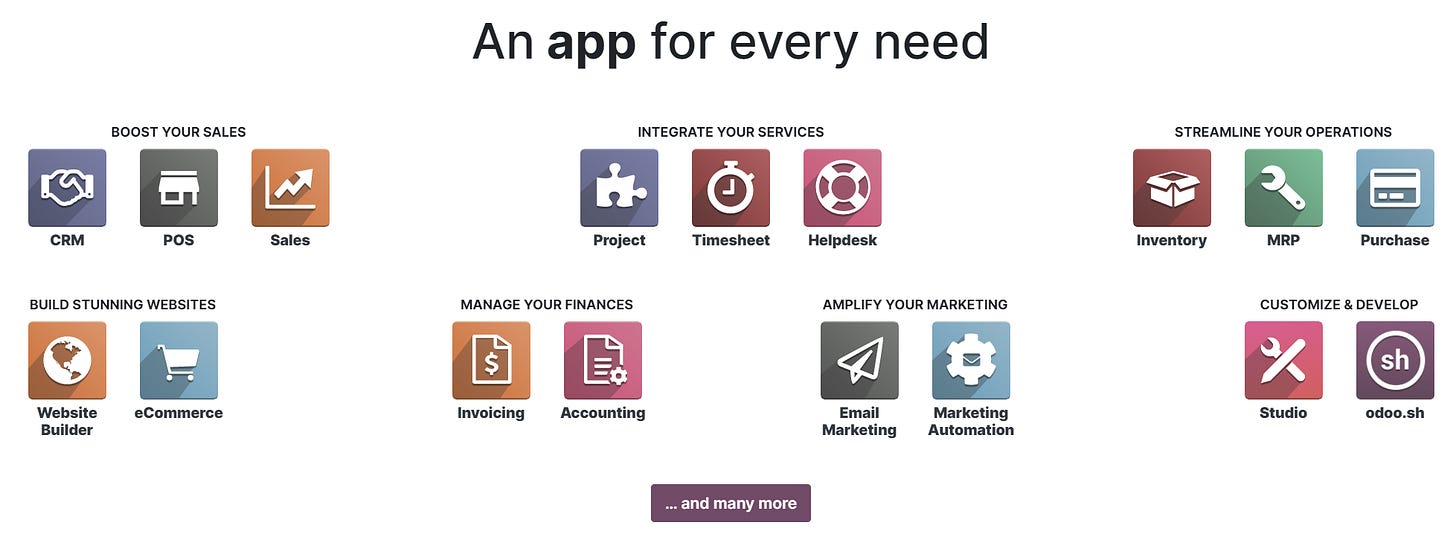How to operate a machine made of 200 employees
#11 - This week, we'll explore actionable strategies to ensure consistent efficiency and success for your business or team.
Welcome to issue #11 of Odoo Trailblazer, our journey to become the #1 Odoo partner. This week we’ll review what you can implement so your business or team works consistently well.


TL;DR:
A business can be seen as a machine, where you often need to step back and look at the grand design to ensure it keeps working as expected.
We share that many tools or artefacts can be implemented, but you don’t have a single bullet.
We’ve made many mistakes in implementing each of them and are sharing our own mistakes and lessons.
In case you missed it, you can discover;
The previous issues of this newsletter
How we help companies to use Odoo
How we help other Odoo partners implement complex projects.
Agenda
Introduction & Scope
Management Artefacts
Objective
Business process
Bonus
Data reporting
IT system
Communication process
Motivation
Conclusion
1. Introduction
Today we’ll visualize our business as if it is a giant machine.
In business, a manager typically assigns some resources (money, assets, employees, …) and defines some objectives.
Then they expect the team to produce an outcome (e.g. manufacture products, deliver services, acquire customers). In practice, it is never easy, especially if you want your outcome to be consistent.
In my own experience, I’ve found it useful to think of it as a machine made of vendors and employees. In practice, it means to step back and look at the grand design.
How are the people operating together? What will motivate each person? How do we ensure that these critical steps are done properly? What happens if a task is not done? How do we maintain the organization so it still works well in 6 months?
To make sure an organization works and keeps working, there are many “artefacts” that we can put in place:
Designing business processes
Defining clear objectives and targets for each employee
Giving the right incentives and bonus schema
Measuring the right KPI
Implementing an IT system or the right tools (this is what my business does)
Motivating all team members behind one unique goal
Having the right communication, 1-1 review, and routines in place.
A typical common mistake I’ve seen with my management team is a manager implementing the right bonus schema or business processes and expecting everything to work perfectly.
In some cases, defining the right objectives or the right business process will work well the first week, but not consistently. For your system to be resilient, you often need a combination of several artefacts.
2. Management Artefacts
Here are some of the artefacts I try to implement in each of our teams or department.
Objective
Each of your employees, or at least each team, needs to have clear objectives. The framework I prefer is the OKR (objective and key results):
The objectives are what we try to achieve
The key results are the intermediary results that contribute to achieving the overall objective.
I like it because of its duality: the objectives help us understand the big picture about what we need to do, and the key results force people to achieve short-term results that directly impact the overall goal.
Most common mistakes: not defining clear objectives and expected short term results for your team, or not reviewing it frequently enough
Business process
A business process is a clear guide on how to operate. It is useful to standardize results. It will improve the quality and consistency and often reduce the costs of your output.
In the beginning, you don’t need a business process; instead, you should focus on results, delivering to your client, controlling your costs, and satisfying your clients.
Once you learn what works best and the typical mistakes, you should formalize it into a business process so you can grow your operations.
Most common mistakes: implementing a business process too early or too late.
Example at Port Cities: we’ve very detailed processes for the project management and development of Odoo apps. Although each project is unique, we still formalize some generic steps to control quality and costs in detail.
Bonus
In some cases, a bonus is very useful for one or several of the following reasons:
The extra mile: encourage your employee to go the extra mile to deliver results. It is especially useful for salespeople because, without this extra mile, you’ll usually not sell at all.
Increase package: it is the most effective way to increase your team's compensation while limiting the business risks. To work, the bonus must be directly linked to the team or individual impact on profit and loss.
Motivation is one element that could motivate your team to give their best every day.
Most common mistakes: believing that a bonus is enough to encourage people to make the right decisions. We even noticed that many employees don’t do simple tasks that could easily improve their bonus. Bonuses work for some people in some specific contexts.
Example at Port Cities: our sales team is incentivized on the revenue they generate, our directors on the EBIT, and our project managers on the gross margin of their project and the company performance in general.
IT system
IT systems can help you to ensure that business processes are done more efficiently (by automating some tasks, offering self-service options to clients, or easily retrieving information) and help you to manage them (control processes, easily get reports and KPIs).
Most common mistakes we’ve made: implementing a system before your team or business processes are mature enough, because once you implement some IT tools, it becomes less flexible and harder to change.
My job is to help companies to implement IT systems, so if you know someone in need, please recommend him to look at our website or contact me.
Data reporting
Before implementing IT systems, the right procedure, and bonuses, looking at the results and, more specifically, the data is more important.
How much did you sell? How many percents of the product shipped on time? How much does it cost?
You don’t need a big business or complex IT system to be data-driven. You can and should start looking at the data from day one in a very manual way.
Most common mistakes: implementing KPIs and dashboards, but not having the right routines to control it and take action. Managers are not “owner”, and some of them will not care as much as you do if the data are not good. You actually need the right routines to make sure that we discuss and take actions when some results aren’t good.
Once an organization is bigger, it is very useful to design and implement your IT system in a way you get the right data and reports.
This is also what we do at Port Cities: we make sure that the Odoo is well implemented, help our clients integrate software together, and provide data solutions to make it work at scale.
Example at Port Cities: we generate reports in Google Sheets, Metabase (a BI tool), or directly from Odoo. Almost all our data are coming from Odoo.
Communication process
Even with a well-defined business process and great IT tools, your business will have issues and exceptions to deal with. So you need the right communication practices and routines to ensure things get resolved quickly.
You also need to have a routine to review the items above, such as analyzing the data or the OKR and reviewing your team's performance and bonus.
The above items will quickly become irrelevant without all these routines and practices.
Most common mistakes: our organization grew quickly over the last few years, and it often required to change the team objective, KPI, etc. We often failed to adjust quickly enough our communication processes to meet this new reality.
Motivation
There are many ways to motivate people at work, but no single action will be enough.
Here are some of the things we can do: set the right compensation, an inspiring vision, clear company goals, a good atmosphere in the office, nice perks, a good manager, work flexibility, a development plan, etc.
Most common mistakes: believing that people are driven by the same things. Everyone care to some extents about their base salary, but other items will have very different impacts depends on the people.
3. Conclusion
A business or a team can be seen as a machine, so you can step back from daily operations to improve the design and fix the issues.
But you should not forget that it is a machine made of humans that are all unique, have different emotional chemistry, and have the power to become superheroes if they are in the right conditions.
See you next week!
Follow us on LinkedIn for more updates: Gaspard (Founder & CEO) or Port Cities (our company page).
To learn more about Port Cities and how we help companies use Odoo (business software), visit our website.



Hello Gaspard,
thank you for an interesting newsletter! I like it. If you will need a partner in Poland, you can reach out to me :) https://www.linkedin.com/in/akselnooit/